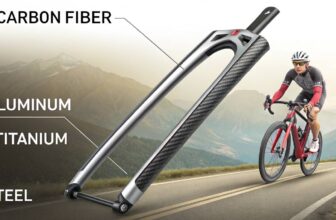Frame Material Comparison
Choosing your road bike’s frame material isn’t just a mundane choice; it’s like picking a dance partner for your cycling journey. Let’s break down the nitty-gritty between Carbon and Aluminum frames by diving into their weight, comfort, durability, and the all-important dollar factor.
Weight Variance: Carbon vs Aluminum
Weight is a big deal for those who love to zip past the competition. Carbon frames are usually the featherweights in the room, with complete bikes tipping the scales at less than 15 pounds. Aluminum, on the other hand, isn’t far behind but weighs around 18 to 20 pounds.
| Frame Material | Typical Weight (Complete Bike) |
|---|---|
| Carbon | < 15 lbs |
| Aluminum | ~ 18 – 20 lbs |
That extra heft in aluminum might not seem like a lot, but for racers and endurance enthusiasts, every ounce counts when you’re chasing bragging rights.
Comfort and Efficiency
Riding comfort is where Carbon shines. It’s like a couch on wheels for those bumpy roads thanks to how it can be crafted—stiff where it counts, flexible where it matters. Aluminum, while efficient, might leave you feeling a bit like you’ve been through a washing machine on spin cycle.
| Frame Material | Comfort on Rough Roads | Efficiency under Pedaling |
|---|---|---|
| Carbon | High | High |
| Aluminum | Medium | High |
So, if you’re the type who enjoys “easy like Sunday morning” rides, Carbon’s your buddy.
Durability and Repairability
Durability? Let’s talk brass tacks. Carbon frames, with their strong-to-lightweight magic, can go the distance. They’re tough but can nick easily from a stray rock. Luckily, they bounce back pretty well after a bit of TLC.
| Frame Material | Strength-to-Weight Ratio | Susceptibility to Direct Impact | Repairability |
|---|---|---|---|
| Carbon | High | High | High |
| Aluminum | Medium | Low | Low |
For the go-big-or-go-home types who worry about a random tumble, Carbon still stands tall despite its delicate tendencies.
Cost and Components
Aluminum’s the budget-friendly champ here, while Carbon sits loftily with a fancier price tag thanks to its complex crafting. But both can be real lookers on the road, showing off whatever bling the manufacturers throw at them.
| Frame Material | Average Cost | Aesthetic Options |
|---|---|---|
| Carbon | $$ | High |
| Aluminum | $ | High |
For those swapping bikes or zooming to work, the Carbon cost might give pause, but Aluminum keeps the dream alive and thrifty.
With these insights, whether you’re a newbie, a speed demon, or just sprucing up your two-wheeler, you’ll be better informed when making the call between a slick Carbon or trusty Aluminum frame. Need more deets on bike parts? Check out our handy guides on road bike components and maintenance tips. Happy cycling!
Wheel Size Explained
Picking the right wheels for your bicycle is a bit like finding the perfect pair of shoes. Your choice can make or break your ride. Let’s roll through the history of bike wheels, visit some odd sizes, chat about the ever-popular 26-inch wheels, and cruise on over to the standard 700c variety.
Evolution of Wheel Sizes
Back in the groovy ‘70s and ‘80s, bikers were all about that ISO 630mm wheel on American road bikes. It was like the bell-bottoms of the bike world! These wheels were a smidge bigger than the 700c wheels folks use now, but finding tires was like trying to find sideburns on a teenager — tricky!
Uncommon Wheel Sizes
Ever see a bike and go, “Whoa, those wheels look huge!” It’s not your imagination. Some wheels are specially sized, like 32 to 36 inches, for those who find basketball comfortable but doorways a squeeze, like Shaq. They’re rare in the store, given they’re purpose-built for some rather tall tales, or folks.
The popularity of 26″ Wheels
The 26-inch size is the Swiss army knife with wheels. Born in the age when cruisers ruled the road, this size became the darling of mountain bikers. These wheels love getting dirty, gripping rough trails like a dog with a bone. No wonder they’ve been around so long — they’re rugged, dependable, and won’t easily let you down.
Standard 700c Wheels
Let’s talk 700c: the speed demons of the biking world. With an ISO diameter of 622mm, these are the Ferraris for roadies. Designed to cut through the air with grace, narrowing down to pure efficiency for smooth roads. Whether you’re racing a friend or pedaling to work, 700c wheels are like that barista who remembers your name — reliable and awesome every time.
| Wheel Size | ISO Diameter | Typical Adventure |
|---|---|---|
| 630mm | N/A | Retro road bikes from way back when |
| 32″ | N/A | Custom rides for the vertically gifted |
| 36″ | N/A | Giant wheels for giants — also customized |
| 26″ | 559mm | Mountain trails and sunny beachside cruises |
| 700c | 622mm | Commuting, racing, and long rides into the sunset |
Got questions about bike setups? Curious about road bike sizing or road bike geometry? We’ve got you! Swing by our guides for more insights. Keeping your bike in top shape? Don’t miss out on tips about the perfect road bike tire pressure and road cycling techniques. Trust us, your bike will thank you!




